|
|
|
Sort Order |
|
|
|
Items / Page
|
|
|
|
|
|
|
| Srl | Item |
| 1 |
ID:
153010
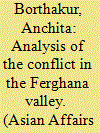

|
|
|
|
|
| Summary/Abstract |
The Ferghana valley which is an ethnically and culturally complex region divided among three Central Asian Republics of Kyrgyzstan, Tajikistan and Uzbekistan, witnessed a number of problems ranging from inter- ethnic tensions to border incursions; from security related complications to a number of socio- economic difficulties in the recent years. Moreover, it is also the most densely populated areas in Central Asia. Though sometimes the threat of religious extremism and intolerance in the Ferghana valley has been exaggerated yet it is difficult to completely deny their presence in the region and the obvious threat it has been posing for the entire Central Asia in future. The artificial delineation of border in the Ferghana valley which was finalized during the soviet era can be considered as one of the principle reasons behind the occurrences of various conflicts in the valley especially after the disintegration of the Soviet Union. Similarly, economy also plays a pivotal role in accentuating the conflict in the region as it is found that the root cause of majority of the conflicts prevalent in the region are regarding the domination of a particular ethnic group on the economic resources of that very area. However, the rivalry between the elites of the three republics and their struggle for power also play a prominent role in the disturbances that has been taking place in Ferghana valley as the elites of the valley do not want to lose their predominant position in the newly formed political establishments of their respective republics.
|
|
|
|
|
|
|
|
|
|
|
|
|
|
|
|
| 2 |
ID:
153870
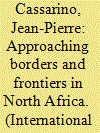

|
|
|
|
|
| Summary/Abstract |
Recent policy developments in the western Mediterranean, especially in North Africa, pose an important puzzle for our understanding of borders and frontiers and the ways in which they are politically addressed. This article sets out to analyse their various implications for patterns of interdependence among states, territoriality, sovereignty, mobility, and last but not least, for domestic politics. By drawing on a vast corpus, the study provides a broader interpretation of such implications which, as argued, cannot be captured with exclusive reference to securitization and processes of demarcation. This endeavour is important to explore how the power dimension in the borderland may interact with other dimensions of the border. Each disciplinary approach discussed in this study, including its heuristic devices, provides a valid explanation of the oft-cited disconnect that scholars have observed in North Africa between the territorially bounded ideal-type of the nation-state and the ways in which it is concretely translated, if not reinterpreted, by borderlanders. An important insight is to venture far beyond disciplinary dogmatism with a view to addressing an array of drivers (be they political, historical, social, economic and geostrategic) that propels bordering practices in North Africa and determines, by the same token, their effects on the ground.
|
|
|
|
|
|
|
|
|
|
|
|
|
|
|
|
| 3 |
ID:
161714
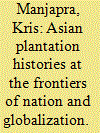

|
|
|
|
|
| Summary/Abstract |
This is a review article of four new books on plantation histories of Asia which offer a sophisticated analysis of the configurations of liberal imperialism, colonial capitalism, and the construction of post-colonial nationalism in the nineteenth and twentieth centuries. The works discussed here are Rana Behal's A hundred years of servitude (2014); Jayeeta Sharma's Empire's garden (2011); Ulbe Bosma's The sugar plantation in India and Indonesia (2013); and Kumari Jayawardena and Rachel Kurian's Class, patriarchy and ethnicity on Sri Lankan plantations (2015).
|
|
|
|
|
|
|
|
|
|
|
|
|
|
|
|
| 4 |
ID:
095745


|
|
|
| 5 |
ID:
175072
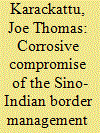

|
|
|
|
|
| Summary/Abstract |
India and China have entered a new low in their bilateral relations. Having fought a war in 1962, it took over three decades for both countries to achieve normalcy at the borders, aided by a series of border management agreements and protocols to maintain tranquility along the border areas. However, the June 2020 Galwan clashes have changed that permanently. This paper argues that the current escalation of border clashes is both a symptom and consequence of the breakdown of the bilateral border management framework which has been dented since the 2017 Doklam standoff between both countries. Delving into diplomatic history relating to Doklam and Galwan, the findings point to the need to correct the epistemic criteria used to reproduce claims of an unambiguous boundary between India and China by both countries, in order to ensure abatement of similar outcomes.
|
|
|
|
|
|
|
|
|
|
|
|
|
|
|
|
| 6 |
ID:
189549


|
|
|
|
|
| Summary/Abstract |
In the months leading up to the transfer of power in India, the eastern Himalayan kingdom of Sikkim made several representations to the Cabinet Mission and other constitutional bodies that were giving shape to the successor Indian government. The Sikkim Darbar was worried that its ambiguous position under colonial treaties might lead India to treat it as one of the five-hundred odd princely states that were slowly merging with the union. In letters, memoranda, legal briefs, and personal meetings, the Darbar argued that it was racially, religiously, socially, and culturally distinct from India, and that its allegiance lied to its north with Tibet. This article traces the vocabulary for the Sikkim Darbar’s assertion of difference from India back to the racialised imperial writing and realpolitik that had informed colonial policy towards the Himalayan states since the nineteenth century, most notably Olaf Caroe’s 1940 thesis on the ‘Mongolian Fringe’. This archival evidence emphasises Sikkimese agency and helps excavate an imagination of the Himalaya from within the region. The article also nuances the history of the forging of Indian republic by foregrounding the processes of negotiation and compromise that continued to shape the territorial contours of the Indian nation long after the moment of decolonisation.
|
|
|
|
|
|
|
|
|
|
|
|
|
|
|
|
| 7 |
ID:
178284
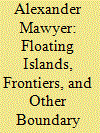

|
|
|
|
|
| Summary/Abstract |
Technological advances have challenged numerous social and political domains over recent decades, including the materialities and imaginaries of islands and islandness in Oceania. Since the early 2000s, a plurality of schemes, discourses, politics, anxieties, and hopes have coalesced around the possible construction of artificial islands, referred to as floating islands, floating nations, floating cities, or seasteads, depending on the new islands’ imagined purposes and peoples. If achieved, these new, de novo, islands will contribute to an ongoing regional geopolitical remaking that requires urgent attention. However, in examining floating islands as boundary objects, this article suggests that, even if never realized, they are exceptional points of focus for perceiving and reflecting on the uncanny, disruptive character of capital at work in the contemporary Pacific Islands in tension with multi-state regional policy initiatives for collective governance and sustainable ocean management. Moreover, this article argues that floating islands are not the only “artificial islands” producing tensions between communities, states, and international ocean governance frameworks. Deep-sea concessions for mineral exploitation, the spatialization of high-seas fishing rights, and large- and small-scale conservation zones similarly raise issues of the fixity or fluidity of territoriality, sovereignty, rights of access and restriction to common or uncommon marine spaces and their resources, as well as conflicting imaginaries and ideologies around the ocean and Oceania as an open frontier.
|
|
|
|
|
|
|
|
|
|
|
|
|
|
|
|
| 8 |
ID:
156824
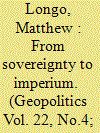

|
|
|
|
|
| Summary/Abstract |
Borders are changing in myriad and multifaceted ways. After 9/11, states redoubled efforts at shoring up their perimeters and building walls. But borders are not merely increasingly securitized, they are also becoming thicker and bi-national. This new ‘zonal’ border emerging worldwide radically shifts the debate about borders and sovereignty. If sovereignty is indivisible, unitary and final, how can it be shared between states at their mutual perimeters? Is this really evidence of sovereignty waning? In this article, I suggest we are stuck at this conceptual impasse because of two conflations. The first one involves two aspects of sovereignty: authority and control. Looking at borders as thin jurisdictional lines, we observe only their legal authority (de jure); instead, by examining changing modes of control, we can see how new securitized borders actually reinforce state strength. The second conflation revolves around the conceptual linking of borders, states and sovereignty. This article argues that as borders thicken, they start to resemble frontiers, and sovereignty starts to resemble imperium – a Roman designation for political authority that is territorially unbounded. This disrupts the border/state dyad and situates borders (lines) and frontiers (zones) on a continuum. In doing so, it reveals how sovereignty is not waning, but changing shape – a worrisome geopolitical conclusion given the possibilities of neo-Imperialism due to power asymmetries between neighbouring states.
|
|
|
|
|
|
|
|
|
|
|
|
|
|
|
|
| 9 |
ID:
147454
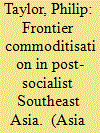

|
|
|
|
|
| Summary/Abstract |
The articles in this special issue examine processes of commoditisation in the frontiers of post-socialist Southeast Asia. Focusing on livelihood transformations in the borderlands of Laos, Cambodia, Vietnam and Thailand, the case studies reveal how relatively understudied actors, networks, flows and conjunctures initiate and shape commodity booms. Exploring how borderlanders engage, resist, cope with and survive commoditisation, the articles chart associated changes in values and in people's relations with each-other and their environment. This introductory article contextualises this new research and discusses the implications of the findings.
|
|
|
|
|
|
|
|
|
|
|
|
|
|
|
|
| 10 |
ID:
138719
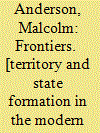

|
|
|
|
|
| Publication |
Cambridge, Polity Press, 1996.
|
| Description |
255p.Hbk
|
| Contents |
B
|
| Standard Number |
0745616526
|
|
|
|
|
|
|
|
|
|
|
|
Copies: C:1/I:0,R:0,Q:0
Circulation
| Accession# | Call# | Current Location | Status | Policy | Location |
| 058203 | 341.42/AND 058203 | Main | On Shelf | General | |
|
|
|
|
| 11 |
ID:
176992
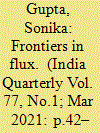

|
|
|
|
|
| Summary/Abstract |
On the eve of Indian Independence, as Britain prepared to devolve the Crown’s treaties with Tibet to the Indian government, the Tibetan government was debating its future treaty relationship with India under the 1914 Simla Convention and associated Indo-Tibetan Trade Regulations. Soon after Indian independence, Tibetan government made an expansive demand for return of Tibetan territory along the McMahon Line and beyond. This led to a long diplomatic exchange between Lhasa, New Delhi and London as India deliberated its response to the Tibetan demand. This article decodes the voluminous correspondence between February 1947 and January 1948 that flowed between the British/Indian Mission in Lhasa, the Political Officer in Sikkim, External Affairs Ministry in Delhi and the Foreign Office in London, on the Simla Convention and the ensuing Tibetan territorial demand. Housed at the National Archives in New Delhi, this declassified confidential communication provides crucial context for newly independent Indian state’s relationship with Tibet. It also reveals the intricacies of Tibetan elite politics that affected decision-making in Lhasa translating to a fragmented and often contradictory policy in forging its new relationship with India. Most importantly, this Tibetan territorial demand undermined the diplomatic efficacy of Tibet’s 1947 Trade Mission to India entangling its outcome with the resolution of this issue. This was a lost opportunity for both India and Tibet in building an agreement on the frontier which worked to their mutual disadvantage in the future.
|
|
|
|
|
|
|
|
|
|
|
|
|
|
|
|
| 12 |
ID:
152197
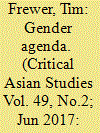

|
|
|
|
|
| Summary/Abstract |
Cambodia’s mountainous northeastern province of Ratanakiri, which only twenty years ago was home to mainly indigenous minority groups largely focused on subsistence production, has undergone rapid ecological, social, and economic transformation. Deforestation and land alienation in the context of large-scale plantation agriculture, land speculation, and smallholder cash cropping have led to concerns that indigenous communities are being alienated from their land and not benefitting from economic changes. This has resulted in a significant number of NGO and government programs that attempt to protect and “empower” indigenous people, particularly women. This article examines a one-year research project which explored the relationship between indigenous women and land change in two indigenous villages. It discusses how indigenous women as well as Khmer and landless Cham immigrants have dealt with the commoditization of land and labor. It focuses on the differentiated way capitalist relations have pushed men, women, landless laborers, and increasingly wealthy landowners on increasingly divergent life trajectories. Compelled by donors to focus on gender and indigenous women as an object of governance, the NGO that directed this project struggled to keep up with the realities of capitalist relations on the ground.
|
|
|
|
|
|
|
|
|
|
|
|
|
|
|
|
| 13 |
ID:
187285
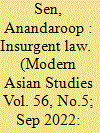

|
|
|
|
|
| Summary/Abstract |
This article studies the adjudicatory practices deployed by colonial military and police forces during a series of punitive British expeditions in the eastern frontiers of British India and the northern reaches of British Burma, specifically the Lushai and Chin Hills in the late nineteenth century. It magnifies the lives, deaths, and afterlives of two ‘tribal’ chiefs of Lushai Hills. Among others, these figures were held responsible for a series of raids carried out in the settled British territories of the northeastern frontiers in the 1890s. After a few inconclusive skirmishes with the British expeditionary force, they were apprehended and imprisoned in a jail in Hazaribagh under the preventive detention act of Bengal Regulation III of 1818, which was reserved and designed to arrest political dissidents of the empire. After a few months, two of them, Liengpunga and Khalkam, were found hanging from the windows of their prison latrine. The British administration labelled these deaths as suicides and closed the cases. The article opens them up. In doing so, it narrates an oblique history of the Scheduled District Act of 1874 which removed hill districts from the jurisdictions of regular courts. By focusing on the historical imbrication of Bengal Regulation III of 1818 in the Scheduled District Act, the article highlights the punitive techniques embedded in the seeming protectionist impulse of the colonial state, something that persists in India's administration of the Northeast region. Closer to the concerns of this issue, it reflects on a legal genealogy of tribal subjects in South Asia.
|
|
|
|
|
|
|
|
|
|
|
|
|
|
|
|
| 14 |
ID:
178280


|
|
|
|
|
| Summary/Abstract |
Over the last decades, the Pacific Ocean has been the locus of an unequalled rush for space and resources involving intertwined public and corporate interests, external powers, and Pacific Island states and territories. This rush is driven by three intersecting motivations aiming to: (1) exploit marine resources; (2) protect marine biodiversity and mitigate the effects of climate change; and (3) establish sovereignties over marine spaces. In this context, the fluidity of saltwater environments gives rise to specific issues of enforcement, control, and governance. This special issue examines these reconfigurations of/in the Pacific Ocean, stressing potentially conflicting frontier processes, in the light of a structuring tension between trends of ocean grabbing and ocean commoning.
|
|
|
|
|
|
|
|
|
|
|
|
|
|
|
|
| 15 |
ID:
153418


|
|
|
|
|
| Summary/Abstract |
Changes in the nature, scale, and speed of natural resource extraction, especially in the last two decades, have resulted in many new resource extraction areas emerging across the world. By zooming in on Indonesia, this article shows that the underlying causes and consequences of current trends are more complex than portrayed by the rancher-squatter model of frontiers that is still frequently used to explain these developments. We argue that a broadened frontier notion is necessary to address the multifaceted nature of the processes underway in contemporary Indonesian extraction areas, as well as beyond. We propose a perspective that pays explicit attention to four new developments that can be described by using the hybridization of space, time, actors, and rules, and are characterized by the fact that these processes create new perimeters in all four mentioned areas. In so doing, we challenge, broaden, and renew the meaning of frontiers.
|
|
|
|
|
|
|
|
|
|
|
|
|
|
|
|
| 16 |
ID:
189360


|
|
|
|
|
| Summary/Abstract |
Myanmar, a nation situated between India, China and Southeast Asia, has long histories of colonialism, violence, and resource extraction. This special issue introduction, written in the midst of Myanmar’s 2021 military coup and the COVID-19 pandemic, offers two critical and feminist interventions – ‘remaking’ and ‘living with’ – to understand the contested and embodied political geographies of extractive resource frontiers in Myanmar. ‘Remaking’ focuses on the long roots of resource frontiers, underscoring the historical and spatial processes through which Myanmar’s plural authorities have restructured diverse territories for accumulation and extraction from the pre-colonial period to the recent ‘democratic transition’. ‘Living with’ resource frontiers bring attention to people’s everyday lives, and why and how they adapt, resist, comply, suffer and profit from resource frontiers. In bringing together a diverse set of literatures with original empirical research, the articles in this collection offer analyses of Myanmar’s pre-coup period that inform contemporary post-coup politics. Together, they demonstrate the material, affective, and embodied nature of resource frontiers as they are (re)made and lived with – in and beyond militarised spaces like Myanmar.
|
|
|
|
|
|
|
|
|
|
|
|
|
|
|
|
| 17 |
ID:
094320
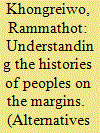

|
|
|
|
|
| Publication |
2009.
|
| Summary/Abstract |
This article examines the often misconceived problem of insurgency and various political, social, and law and order problems of northeast India, which Sanjib Baruah calls “Northeast India's Durable Disorder.” The region has been stereotyped by the post-colonial state of India as a “disturbed area” infested with insurgents and militants. In its attempts to resolve this “durable disorder,” India fails to engage with its underlying causes in the construction of new political boundaries in both the colonial and postcolonial eras.
|
|
|
|
|
|
|
|
|
|
|
|
|
|
|
|
| 18 |
ID:
193196


|
|
|
|
|
| Summary/Abstract |
Frontier making in Ethiopia has historical roots from the formation of the modern Ethiopian state in the late-19th century through wars of conquest. The conquest, which was inspired by political and economic motivations of the highland Christian kingdom, used the notion of a “civilizing mission”—civilizing the “backward” and “underdeveloped” people, and “underutilized” spaces—through imposition of an imperial state system and Orthodox Christianity. The foundation and horizontal expansion of Addis Ababa or Finfinne by displacing Indigenous inhabitants was part of the state building project under successive regimes. Over the last century and a half, the city has continued its unchecked expansion in a process involving multilayered actors whose interests overlapped in terms of grabbing the land they considered “underutilized.” More specifically, the last three decades evince commoditization of farmlands, grazing areas, and cultural and sacred spaces through land lease, which eventually dissolve existing customary systems, values, and practices. This paper critically analyzes the dynamics of frontier making in or from Addis Ababa or Finfinne, the political economy behind such unchecked frontier expansion and how it activated the power of resistance in 2014. The paper concludes that frontier making in or from Addis Ababa through dispossession of Oromo farmers has been part of the broader political establishment in Ethiopia and should be viewed within the same lens.
|
|
|
|
|
|
|
|
|
|
|
|
|
|
|
|
|
|
|
|
|